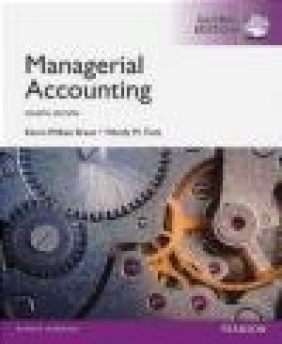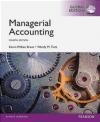Managerial Accounting, Global Edition
Wendy Tietz, Karen Braun
Managerial Accounting, Global Edition
Wendy Tietz, Karen Braun
- Producent: Pearson
- Rok produkcji: 2014
- ISBN: 9781292059426
- Ilość stron: 960
- Oprawa: Miękka
Niedostępna
Opis: Managerial Accounting, Global Edition - Wendy Tietz, Karen Braun
For courses in Introduction to Management Accounting This text helps students make the connection between managerial accounting concepts and the businesses they deal with everyday through strong coverage and effective practice. By presenting actual accounting decisions made in companies like Target and J. Crew, the text's precise coverage of the core concepts engages students in the learning process. MyAccountingLab for Managerial Accounting is an online homework, tutorial, and assessment program that truly engages students in learning. It helps students better prepare for class, quizzes, and exams-resulting in better performance in the course-and provides educators with a dynamic set of tools for gauging individual and class progress. This program provides a better teaching and learning experience-for you and your students. Here's how: *Personalized learning with MyAccountingLab-the online homework, tutorial and assessment program that helps students succeed in the classroom and beyond. *Students see the connections between accounting concepts and the businesses they interact with everyday. *Students learn from the latest information on important topics in the field1 Introduction to Managerial Accounting 1 What is Managerial Accounting? 2 Managers' Three Primary Responsibilities 2 A Road Map: How Managerial Accounting Fits In 3 Differences Between Managerial Accounting and Financial Accounting 4 What Role do Management Accountants Play? 6 Organizational Structure 6 The Changing Roles of Management Accountants 7 The Skills Required of Management Accountants 8 Professional Associations 9 Average Salaries of Management Accountants 10 Ethics 11 Examples of Ethical Dilemmas 12 What Regulatory Issues Affect Management Accounting? 17 Sarbanes-Oxley Act of 2002 17 International Financial Reporting Standards (IFRS) 18 Extensible Business Reporting Language (XBRL) 18 What Business Trends Affect Management Accounting? 19 Sustainability, Social Responsibility, and the Triple Bottom Line 19 Integrated Reporting 20 Shifting Economy 21 Global Marketplace 21 Advanced Information Systems 22 Lean Operations 23 Total Quality Management 23 End of Chapter 27 2 Building Blocks of Managerial Accounting 46 What are the Most Common Business Sectors and Their Activities? 47 Service, Merchandising, and Manufacturing Companies 47 Which Business Activities Make up the Value Chain? 49 Coordinating Activities Across the Value Chain 50 How do Companies Define Cost? 52 Cost Objects, Direct Costs, and Indirect Costs 52 Costs for Internal Decision Making and External Reporting 54 Merchandising Companies' Inventoriable Product Costs 56 Manufacturing Companies' Inventoriable Product Costs 57 Prime and Conversion Costs 59 Additional Labor Compensation Costs 59 Recap: Inventoriable Product Costs Versus Period Costs 60 How are Inventoriable Product Costs and Period Costs Shown in the Financial Statements? 63 Service Companies 63 Merchandising Companies 63 Manufacturing Companies 65 Comparing Balance Sheets 68 Sustainability and Corporate Reporting 68 What Other Cost Terms are Used by Managers? 69 Controllable Versus Uncontrollable Costs 69 Relevant and Irrelevant Costs 69 Fixed and Variable Costs 70 How Manufacturing Costs Behave 71 Calculating Total and Average Costs 72 End of Chapter 76 3 Job Costing 102 What Methods are Used to Determine the Cost of Manufacturing a Product? 103 Process Costing 103 Job Costing 104 How do Manufacturers Determine a Job's Cost? 105 Overview: Flow of Inventory Through a Manufacturing System 105 Scheduling Production 106 Purchasing Raw Materials 107 Using a Job Cost Record to Accumulate Job Costs 108 Tracing Direct Materials Cost to a Job 110 Tracing Direct Labor Cost to a Job 112 Allocating Manufacturing Overhead to a Job 114 Completing the Job Cost Record and Using it to Make Business Decisions 117 How Can Job Costing Information be Enhanced for Decision Making? 119 Non-Manufacturing Costs 121 Direct or Variable Costing 121 How do Managers Deal with Underallocated or Overallocated Manufacturing Overhead? 125 What Journal Entries are Needed in a Manufacturer's Job Costing System? 127 Appendix 3A 141 How do Service Firms Use Job Costing to Determine the Amount to Bill Clients? 141 What Costs are Considered Direct Costs of Serving the Client? 141 What Costs are Considered Indirect Costs of Serving the Client? 142 Finding the Total Cost of the Job and Adding a Profit Markup 143 Invoicing the Client Using a Professional Billing Rate 143 What Journal Entries are Needed in a Service Firm's Job Costing System? 144 End of Chapter 145 4 Activity-Based Costing, Lean Operations, and the Costs of Quality 176 Why and How do Companies Refine Their Cost Allocation Systems? 177 Simple Cost Allocation Systems Can Lead to Cost Distortion 177 Review: Using a Plantwide Overhead Rate to Allocate Indirect Costs 178 Using Departmental Overhead Rates to Allocate Indirect Costs 180 Using Activity-Based Costing to Allocate Indirect Costs 185 How do Managers Use the Refined Cost Information to Improve Operations? 192 Activity-Based Management (ABM) 192 Passing the Cost-Benefit Test 194 What is Lean Thinking? 200 The Eight Wastes of Traditional Operations 200 Characteristics of Lean Operations 202 Lean Operations in Service and Merchandising Companies 207 How do Managers Improve Quality? 207 Costs of Quality (COQ) 208 Relationship Among Costs 209 Using Costs of Quality Reports to Aid Decisions 210 End of Chapter 215 5 Process Costing 247 Process Costing: An Overview 248 Two Basic Costing Systems: Job Costing and Process Costing 248 How Does the Flow of Costs Differ Between Job and Process Costing? 249 What are the Building Blocks of Process Costing? 252 Conversion Costs 252 Equivalent Units 252 Inventory Flow Assumptions 253 How Does Process Costing Work in the First Processing Department? 254 Step 1: Summarize the Flow of Physical Units 256 Step 2: Compute Output in Terms of Equivalent Units 256 Step 3: Summarize Total Costs to Account For 258 Step 4: Compute the Cost per Equivalent Unit 258 Step 5: Assign Total Costs to Units Completed and to Units in Ending Work in Process Inventory 259 Average Unit Costs 259 What Journal Entries are Needed in a Process Costing System? 261 How Does Process Costing Work in a Second or Later Processing Department? 267 Process Costing in SeaView's Insertion Department 267 Steps 1 and 2: Summarize the Flow of Physical Units and Compute Output in Terms of Equivalent Units 269 Steps 3 and 4: Summarize Total Costs to Account for and Compute the Cost per Equivalent Unit 270 Step 5: Assign Total Costs to Units Completed and to Units in Ending Work in Process Inventory 271 Unit Costs and Gross Profit 271 Production Cost Reports 272 Journal Entries in a Second Processing Department 273 End of Chapter 280 6 Cost Behavior 309 Cost Behavior: How do Changes in Volume Affect Costs? 310 Variable Costs 310 Fixed Costs 313 Mixed Costs 316 Relevant Range 318 Other Cost Behaviors 319 How do Managers Determine Cost Behavior? 324 Account Analysis 324 Scatter Plots 324 High-Low Method 326 Regression Analysis 328 Data Concerns 332 What are the Roles of Variable Costing and the Contribution Margin Income Statement? 333 Comparing Absorption Costing and Variable Costing 333 The Contribution Margin Income Statement 335 Comparing Operating Income: Variable Versus Absorption Costing 338 Reconciling Operating Income Between the Two Costing Systems 340 End of Chapter 347 7 Cost-Volume-Profit Analysis 382 How Does Cost-Volume-Profit Analysis Help Managers? 383 Data and Assumptions Required for CVP Analysis 383 The Unit Contribution Margin 384 The Contribution Margin Ratio 385 How do Managers Find the Breakeven Point? 387 The Income Statement Approach 388 The Shortcut Approach Using the Unit Contribution Margin 389 The Shortcut Approach Using the Contribution Margin Ratio 390 How do Managers Find the Volume Needed to Earn a Target Profit? 391 How Much Must we Sell to Earn a Target Profit? 391 Graphing CVP Relationships 393 How do Managers Use CVP to Plan for Changing Business Conditions? 398 Changing the Sales Price 398 Changing Variable Costs 399 Changing More Than One Factor 400 Changing Fixed Costs 401 Changing the Mix of Products Offered for Sale 403 What are Some Common Indicators of Risk? 407 Margin of Safety 407 Operating Leverage 408 Choosing a Cost Structure 411 End of Chapter 417 8 Relevant Costs for Short-Term Decisions 443 How do Managers Make Decisions? 444 Relevant Information 444 Relevant Nonfinancial Information 445 Keys to Making Short-Term Special Decisions 446 How do Managers Make Special Order and Regular Pricing Decisions? 448 Special Order Decisions 448 Regular Pricing Decisions 452 How do Managers Make Other Special Business Decisions? 460 Decisions to Discontinue Products, Departments, or Stores 460 Product Mix Decisions when Resources are Constrained 464 Outsourcing Decisions (Make or Buy) 466 Decisions to Sell As Is or Process Further 470 End of Chapter 476 9 The Master Budget 502 How and Why do Managers Use Budgets? 503 How are Budgets Used? 503 How are Budgets Developed? 503 What are the Benefits of Budgeting? 505 What is the Master Budget? 506 How are the Operating Budgets Prepared? 507 Sales Budget 507 Production Budget 508 Direct Materials Budget 510 Direct Labor Budget 511 Manufacturing Overhead Budget 512 Operating Expenses Budget 513 Budgeted Income Statement 514 How are the Financial Budgets Prepared? 519 Capital Expenditures Budget 519 Cash Collections Budget 519 Cash Payments Budget 520 Combined Cash Budget 522 Budgeted Balance Sheet 523 Sensitivity Analysis and Flexible Budgeting 525 How do the Budgets for Service and Merchandising Companies Differ? 527 Service Companies 527 Merchandising Companies 527 Impact of Credit and Debit Card Sales on Budgeting 529 End of Chapter 534 10 Performance Evaluation 572 How Does Decentralization Affect Performance Evaluation? 573 Advantages and Disadvantages of Decentralization 573 Performance Evaluation Systems 574 What is Responsibility Accounting? 574 Types of Responsibility Centers 575 Responsibility Center Performance Reports 577 Evaluation of Investment Centers 579 What is Transfer Pricing? 586 Strategies and Mechanisms for Determining a Transfer Price 587 How do Managers Use Flexible Budgets to Evaluate Performance? 593 Creating a Flexible Budget Performance Report 594 Underlying Causes of the Variances 596 How do Companies Incorporate Nonfinancial Performance Measurement? 598 The Balanced Scorecard 598 End of Chapter 607 11 Standard Costs and Variances 642 What are Standard Costs? 643 Types of Standards 643 Information Used to Develop and Update Standards 644 Computing Standard Costs 644 How do Managers Use Standard Costs to Compute DM and DL Variances? 647 Using Standard Costs to Develop the Flexible Budget 647 Direct Materials Variances 647 Direct Labor Variances 653 Summary of Direct Materials and Direct Labor Variances 655 Advantages and Disadvantages of Using Standard Costs and Variances 655 How do Managers Use Standard Costs to Compute MOH Variances? 660 Variable Manufacturing Overhead Variances 660 Fixed Manufacturing Overhead Variances 662 Standard Costing Systems 664 Appendix 11A 668 Standard Costing 668 Standard Costing Income Statement 671 End of Chapter 672 12 Capital Investment Decisions and the Time Value of Money 698 What is Capital Budgeting? 699 Four Popular Methods of Capital Budgeting Analysis 699 Focus on Cash Flows 700 Capital Budgeting Process 700 How do Managers Calculate the Payback Period and Accounting Rate of Return? 702 Payback Period 702 Accounting Rate of Return (ARR) 705 How do Managers Compute the Time Value of Money? 711 Factors Affecting the Time Value of Money 711 Future Values and Present Values: Points Along the Time Continuum 712 Future Value and Present Value Factors 713 Calculating Future Values of Single Sums and Annuities Using FV Factors 714 Calculating Present Values of Single Sums and Annuities Using PV Factors 715 How do Managers Calculate the Net Present Value and Internal Rate of Return? 718 Net Present Value (NPV) 719 Internal Rate of Return (IRR) 724 How do the Capital Budgeting Methods Compare? 727 Appendix 12A 731 Present Value Tables and Future Value Tables 731 Table A Present Value of $1 731 Table B Present Value of Annuity of $1 732 Table C Future Value of $1 733 Table D Future Value of Annuity of $1 734 Appendix 12B 735 Solutions to Chapter Examples Using Microsoft Excel 735 Appendix 12C 739 Using a TI-83, TI-83 Plus, TI-84, or TI-84 Plus Calculator to Perform Time Value of Money Calculations 739 End of Chapter 745 13 Statement of Cash Flows 765 What is the Statement of Cash Flows? 766 Three Types of Activities That Generate and Use Cash 767 Two Methods of Presenting Operating Activities 769 How is the Statement of Cash Flows Prepared Using the Indirect Method? 774 Information Needed to Prepare the Statement of Cash Flows 774 Preparing the Cash Flows from Operating Activities 774 Preparing the Cash Flows from Investing Activities 780 Preparing the Cash Flows from Financing Activities 782 Interpreting the Statement of Cash Flows 784 Recap: Steps to Preparing the Statement of Cash Flows Using the Indirect Method 784 How is the Statement of Cash Flows Prepared Using the Direct Method? 785 Overview 785 Determining Cash Payments and Receipts 786 End of Chapter 794 14 Financial Statement Analysis 823 What are the Most Common Methods of Analysis? 824 Horizontal Analysis 824 Horizontal Analysis of the Income Statement 826 Horizontal Analysis of the Balance Sheet 826 Trend Percentages 826 Vertical Analysis 828 How do we Compare One Company with Another? 830 What are Some of the Most Common Financial Ratios? 835 Measuring Ability to Pay Current Liabilities 835 Measuring Ability to Sell Inventory and Collect Receivables 836 Measuring Ability to Pay Long-Term Debt 838 Measuring Profitability 839 Analyzing Stock Investments 841 Red Flags in Financial Statement Analysis 843 End of Chapter 850 15 Sustainability 876 What is Sustainability and How Does it Create Business Value? 877 Historical Overview 878 The Business Case for Sustainability 879 What is Sustainability Reporting? 883 Current State of Sustainability Reporting 883 Reasons for Sustainability Reporting 884 Framework for Sustainability Reporting 884 What is Environmental Management Accounting (EMA)? 888 EMA Systems 888 Uses of Environmental Management Accounting Information 890 Challenges to Implementing EMA Systems 891 Future of Environmental Management Accounting 893 End of Chapter 895 Company Names Index I-1 Glossary/Index I-5
Producent:
GPSR Pearson Central Europe Sp. z o.o.
ul. Szamocka 8
01-748 Warszawa (PL)
tel: 459 596 060
email: [email protected]
Szczegóły: Managerial Accounting, Global Edition - Wendy Tietz, Karen Braun
Tytuł: Managerial Accounting, Global Edition
Autor: Wendy Tietz, Karen Braun
Producent: Pearson
ISBN: 9781292059426
Rok produkcji: 2014
Ilość stron: 960
Oprawa: Miękka
Waga: 1.79 kg


























